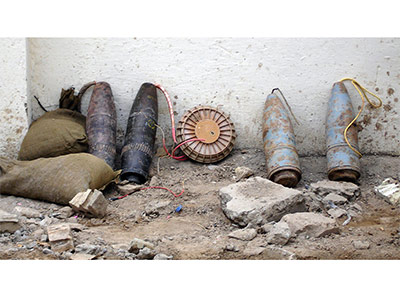Low-Tech Terrorism
Mini Teaser: We fear weapons of mass destruction in terrorist hands. Yet the greater danger continues to from terrorists' older tools—the gun and the bomb.
Perhaps the most novel and innovative use of IEDs, however, has been when they have been paired with toxic chemicals. Much as the Iraq conflict has served as a proving ground for other terrorist weapons and tactics, it has also served this purpose with chemical weapons. Between 2007 and 2010, more than a dozen major truck-bomb attacks occurred in Iraq involving conventional explosions paired with chlorine gas.
The most serious incident, however, was one that was foiled by Jordanian authorities in April 2004. It involved the toxic release of chemicals into a crowded urban environment and was orchestrated by the late Abu Musab al-Zarqawi, the founder and leader of Al Qaeda in Iraq. The Amman plot entailed the use of some twenty tons of chemicals and explosives to target simultaneously the prime minister’s office, the General Intelligence Department’s headquarters and the U.S. embassy. Although the main purpose of the coordinated operations was to conduct forced-entry attacks by suicide bombers against these three heavily protected, high-value targets, an ancillary intention is believed to have been the infliction of mass casualties on the surrounding areas by the noxious chemical agents deliberately released in the blasts. An estimated eighty thousand people, Jordanian authorities claim, would have been killed or seriously injured in the operation.
The above attacks in Iraq and the foiled incident in Amman all underscore the potential for terrorists to attack a domestic industrial chemical facility with a truck bomb or other large explosive device, with the purpose of triggering the release of toxic chemicals. In this respect, the effects of prior industrial accidents involving chemicals may exert a profound influence over terrorists. In 2005, for instance, a train crash and derailment in South Carolina released some sixty tons of liquefied chlorine into the air, killing nine people and injuring 250 others. Considerably more tragic, of course, was the 1984 disaster at a Union Carbide chemical facility in Bhopal, India. Some forty tons of methyl isocyanate were accidentally released into the environment and killed nearly four thousand people living around the plant. Methyl isocyanate is one of the more toxic chemicals used in industry, with a toxicity that is only a few percent less than that of sarin.
THE WAR ON terrorism today generates little interest and even less enthusiasm. A decade of prolonged military deployments to Iraq and Afghanistan has drained both the treasuries and willpower of the United States, Great Britain and many other countries, as well as the ardor and commitment that attended the commencement of this global struggle over a dozen years ago. The killings of leading Al Qaeda figures such as bin Laden and Anwar al-Awlaki—along with some forty other senior commanders and hundreds of the group’s fighters—have sufficiently diminished the threat of terrorism to our war-weary, economically preoccupied nations.
But before we simply conclude that the threat from either Al Qaeda or terrorism has disappeared, it would be prudent to pause and reflect on the expansive dimensions of Al Qaeda’s WMD research-and-development efforts—and also to consider the continuing developments on the opposite end of the technological spectrum that have likewise transformed the threat against conventionally superior militaries and even against superpowers. Like it or not, the war on terrorism continues, abetted by the technological advances of our adversaries and thus far mercifully countered by our own technological prowess—and all the more so by our unyielding vigilance.
Bruce Hoffman is a contributing editor to The National Interest, a senior fellow at the U.S. Military Academy’s Combating Terrorism Center, and a professor and director of the Center for Security Studies at Georgetown University.
Image: Pullquote: As mesmerizingly attractive as nonconventional weapons remain to Al Qaeda and other terrorist organizations, they have mostly proven frustratingly disappointing to whoever has tried to use them.Essay Types: Essay
Pullquote: As mesmerizingly attractive as nonconventional weapons remain to Al Qaeda and other terrorist organizations, they have mostly proven frustratingly disappointing to whoever has tried to use them.Essay Types: Essay 